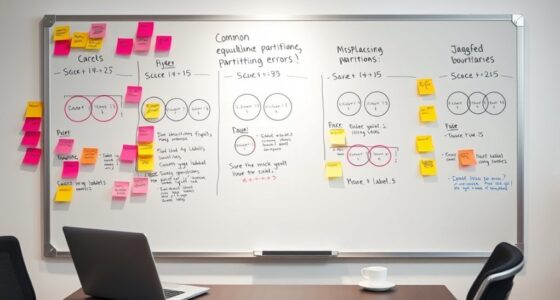Pair testing involves you and a partner working together to find more bugs by sharing ideas, insights, and skills. It improves communication, helps spot issues you might miss alone, and boosts overall test coverage. By collaborating, you both learn from each other and create a better understanding of the software’s quality. If you want to discover effective strategies to make your pairing even more successful, there’s plenty more to explore.
Key Takeaways
- Pair testing combines two testers’ skills and perspectives to identify more defects than solo testing.
- Effective communication, active listening, and shared vocabulary enhance collaboration during pair testing.
- Leveraging complementary strengths allows for broader testing coverage and discovery of diverse issues.
- Clear roles, goals, and open dialogue foster teamwork and improve testing efficiency.
- Pair testing promotes continuous learning, skill sharing, and software quality improvement through collaboration.

Pair testing is a collaborative approach where two testers work together to evaluate a software product. This method leverages the combined skills, perspectives, and insights of two individuals to uncover more defects than you might find alone. When you engage in pair testing, you’re not just sharing the workload; you’re actively exchanging ideas, questioning assumptions, and spotting issues from different angles. To make the most of this process, you need effective collaborative strategies that foster open communication and teamwork. This means establishing a clear understanding of roles, setting shared goals, and creating an environment where both testers feel comfortable voicing concerns or observations. It’s important to remember that successful pair testing isn’t just about finding bugs—it’s about learning from each other and refining your approach as you go.
Pair testing combines two testers’ skills to find more bugs, improve communication, and enhance software quality through collaboration.
However, one of the biggest hurdles you might face in pair testing is communication challenges. These can stem from differing work styles, technical jargon, or even personality clashes. You might find yourself talking past each other or misinterpreting feedback, which can hinder progress rather than accelerate it. To overcome this, you need to develop strong communication skills, such as active listening, asking clarifying questions, and providing constructive feedback. It’s also helpful to agree on a shared vocabulary for discussing issues or features, so you’re both on the same page. Practicing patience and maintaining a respectful attitude can prevent misunderstandings from escalating and ensure that the collaboration remains productive.
Another key to successful pair testing is balancing your different strengths. For example, one tester might excel at exploratory testing, while the other has a keen eye for security vulnerabilities. When you recognize and leverage these complementary skills, you can cover a wider range of testing scenarios more efficiently. This approach encourages continuous learning and helps build a more complete picture of your software’s quality. Additionally, understanding the importance of testing tools and how they can enhance your collaboration is crucial for maximizing efficiency and coverage.
Additionally, maintaining a flexible mindset is essential. Sometimes, your initial plan might need adjustment based on what you discover during testing. Being adaptable allows you to shift focus, explore new areas, or switch roles if needed, ultimately leading to more thorough testing. Remember, the goal of pair testing isn’t just to find bugs quickly but to improve your testing process, enhance communication, and foster a team-oriented mindset that benefits the entire development cycle. With the right collaborative strategies and a commitment to clear communication, you’ll find that pair testing becomes an invaluable tool for delivering higher-quality software.
Frequently Asked Questions
How Does Pair Testing Differ From Solo Testing?
You might wonder how pair testing differs from solo testing. In pair testing, you engage in collaborative communication with a partner, which often leads to more thorough testing and quicker identification of bugs. Paired debugging allows you to approach issues from different perspectives, catching problems faster. Solo testing, on the other hand, relies solely on your skills and perspective, which can sometimes limit the scope of bug detection compared to the collaborative approach.
What Skills Are Essential for Effective Pair Testing?
You need to hit the ground running with strong communication skills and a collaborative mindset. Effective pair testing requires you to share ideas clearly, listen actively, and adapt quickly. You must trust your partner’s insights and contribute constructively. Being open-minded and communicative helps you catch bugs faster and improve testing quality. When you work as a team, you can spot issues that might slip through solo efforts, making the process more efficient.
Can Pair Testing Replace Traditional Testing Methods?
You might wonder if pair testing can replace traditional methods. While it promotes collaborative debugging and shared responsibility, it’s not a complete substitute. Pair testing enhances coverage and catches bugs early, but traditional testing still plays a crucial role in thorough quality assurance. Combining both approaches gives you the best chance to identify issues efficiently, leveraging collaboration without losing the meticulousness of conventional testing processes.
How Do You Resolve Conflicts During Pair Testing?
Think of conflict resolution as steering a rough sea—communication strategies are your compass. During pair testing, you might face disagreements about bug priorities or testing approaches. I once diffused tension by actively listening and paraphrasing their concerns, turning conflict into collaboration. Stay calm, focus on shared goals, and use respectful communication. Clarify misunderstandings quickly, and remember, open dialogue helps turn conflicts into productive discussions.
What Industries Benefit Most From Pair Testing Practices?
You’ll find that industries like software development, healthcare, and finance benefit most from pair testing practices. This approach enhances industry adaptation by fostering close collaboration and quick feedback, which improves team dynamics. By working together, you minimize errors and boost quality. Pair testing helps your team adapt rapidly to changing demands, ensuring more reliable results and higher customer satisfaction across these fast-paced, detail-oriented industries.
Conclusion
Pair testing proves powerful, pairing people to pinpoint problems promptly. By blending brains and bouncing ideas, you build bugs out faster and better. Don’t doubt the dynamic duo of duo testing—delivering diligent, decisive, defect-detecting results. Embrace this engaging, effective method to eliminate errors efficiently. Remember, pairing prompts precision, productivity, and progress. So, step into the synergy, seize the solution, and see how swiftly bugs become bygones with pair testing’s proven power!









